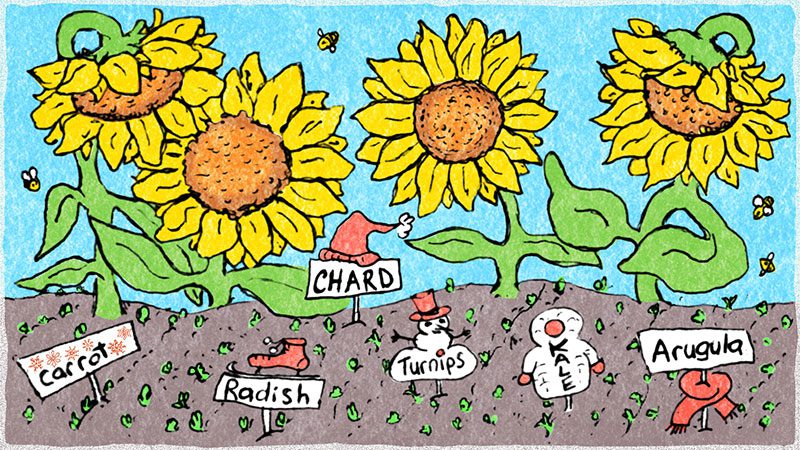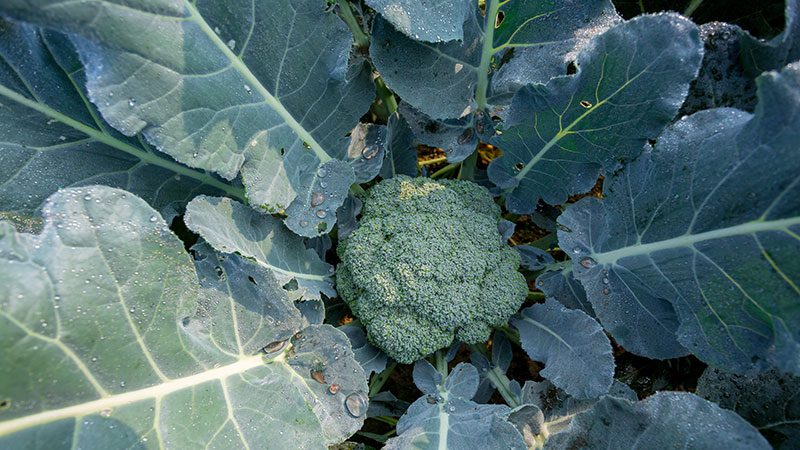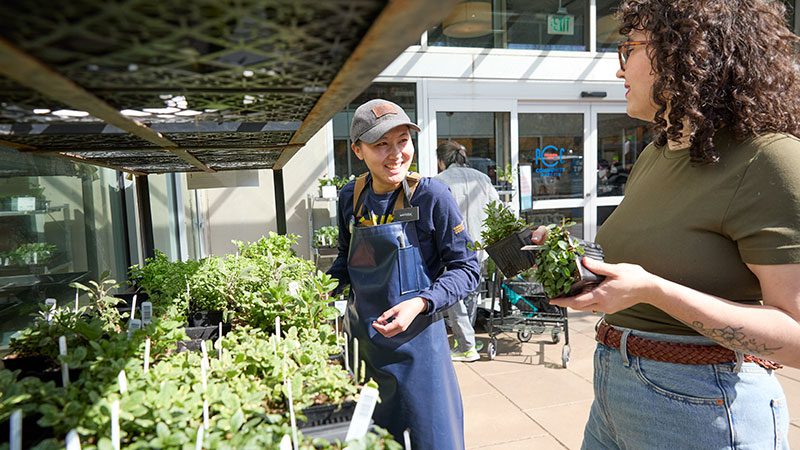It’s time to plant your fall and winter garden
By Tara Austen Weaver, guest contributor

Illustration by Wendy Wahman
We’re lucky, here in the maritime Pacific Northwest, to have a climate mild enough to allow for year-round vegetable growing. That’s what local gardeners like to say—and it’s true. Most of us see snow rarely and can grow vegetables in the cold season, even without hoop houses and other season extenders.
The phrase “fall and winter gardening,” however, is a little misleading. While it is certainly possible to keep some crops going through the cold season, the planting and growing of these gardens needs to happen much sooner. You can’t just pop in some kale starts late October and expect to have your soup and salad needs covered for the winter.
The reality is more like fall and winter harvesting, with late summer growing. This means we need to be thinking, planning, and planting right now. As those spring lettuces and peas complete their growing cycle, space will open up for late season and overwintering crops.
It may feel strange to be starting seeds again, not long after planting out the summer garden, but plants need to take advantage of late summer warmth and sunshine to bulk up for the cooler temperatures ahead. Frost would kill a seedling, while it may only damage the outer leaves of a mature cabbage.

What plants grow in fall and winter?
Some plants even do better in cold weather. Certain types of radishes benefit from cooler days, while frost sweetens the radicchio and kale thrives. It can be an odd experience to harvest radicchio out of a raised bed that was under snow a week or two prior, but strip any weather-beaten outer leaves and you’ll likely find the heart undamaged and tasty.
If you’ve struggled to grow cilantro in the summer heat—which makes it bolt and go to seed—you’ll be delighted by how this herb thrives in the autumn temperature range. Likewise, fall can be a great season for lettuce. While snow or a hard frost will take these tender greens down, it can be a delicious season until then.
What To Plant and When
Here’s a selection of crops that will do well in the fall season—some even overwinter—including recommended cultivars and range of planting dates. Check here too for some of the best local crops you might not be growing — yet.
- Arugula—Astro [August to early September]
- Broccoli—Purple Sprouting Broccoli, White Sprouting, Rudolph. [June to late July].
- Cabbage—Danish Ballhead, Excel, Gloria [June to late July].
- Carrots—Bolero, Merida, Autumn King, Royal Chantenay [mid-July].
- Cilantro—Santo [August and September].
- Collards—Champion, Georgia, Walking Stick [mid-July].
- Kale—Winter Red, Winterbor, Siberian [mid-July to early August].
- Lettuce—Winter Density, Oak Leaf, Little Gem, Top Gun [August]
- Radicchio—Bel Fiore, Fiero, Leonardo [July to early August].
- Radish—Watermelon, Spanish Black, All Season’s White Long, China Rose [late July to late August]
- Spinach—Bloomsdale Savoy, Tyee, Skookum, Olympia [August to early September].
- Swiss Chard—Bright Lights, Perpetual, Dorat, Ruby Red [June-July].
- Turnips—Purple Top White Globe, Tokyo Market, Red Milan [July to early August].

Preparing seedlings for winter
Starting seeds mid-summer can be more of a challenge than spring, as warmer weather means soil dries out faster (some crops, like spinach and lettuce, will not germinate if the soil is too warm). Make sure to keep your beds damp and cool enough for successful germination. Using shade cloth, floating row covers, or even a large shade umbrella can be helpful in controlling soil temperature.
For greatest control and chance of success, gardeners may want to pre-sprout their seeds or grow seedlings indoors. Unlike spring seed starting, you won’t need a heating mat or supplementary light. By the second half of August, garden soil temperatures should be on the decline, but still, make sure tender seedlings get the water they need. It may be wise to water twice a day until they are well established.
As the temperature drops, keep an eye on the forecast and prepare for the first frost in your garden. Make sure to harvest any lettuces or tender greens before they get wiped out—or take precautions to protect them. A clear plastic bottle or milk jug can be cut off at the bottom and provide a layer of insulation from a light frost, and while there are a number of garden products available to protect plants, an old fleece blanket can also be used in a pinch.
If you’d like to get serious about cold season gardening, there are ways to extend the season. You can make a hoop house or cloche, using clear plastic draped over hoops or tubing, which will protect tender plants and create a warmer environment for growth. Likewise, cold frames are low boxes, generally made of wood with a hinged cover of glass or clear plastic that can be propped open for ventilation. These function like a mini greenhouse, amplifying the heat and insulating a bit against the cold.
For those who are really eager to grow in the winter months, hot beds can be built—a planting bed with a heating source at the bottom. Traditionally these have been built with soil on top of a layer of fresh manure. As the manure breaks down over the winter, the decomposition process warms the soil above. These days the same effect can be replicated by burying a heating element under the soil.
All gardening has a bit of surprise to it—certain crops may do well one year and struggle the next. Cold season gardening is no different, though perhaps more extreme. As Pat Patterson writes, in Fall and Winter Vegetable Gardening in the Pacific Northwest, “Keep in mind that fall and winter weather can vary greatly from year to year. A crop that fails one year due to an unusually early freeze or an abnormally cold winter might thrive in a milder year. Be willing to experiment, and don’t give up if your results some years are less than ideal.”
learn more about winter gardening
The Maritime Northwest Garden Guide (Seattle Tilth).
Fall and Winter Vegetable Gardening in the Pacific Northwest (OSU, 2001).
The Year-Round Vegetable Gardener: How to Grow Your Own Food 365 Days a Year, by Niki Jabbour (Storey Publishing, 2011).
Tara Austen Weaver is a writer, editor, and author of seven books, including Growing Berries and Fruit Trees in the Pacific Northwest and the Little Book of Flowers series: Peonies, Dahlias, and Tulips.
PCC and winter gardening
It seems obvious now that year-round gardening is possible in the Northwest, but we owe a lot of that realization to Binda Colebrook. Colebrook, who moved from Massachusetts to Seattle in 1971, was delighted to find that kale and parsley would thrive here through the winter. In 1975, PCC produce manager Rick Erickson convinced Colebrook to teach some gardening classes and see what others were doing in the region to see if local farmers could produce winter vegetables for the co-op.
Colebrook wrote in a 1976 Sound Consumer article that she never would have presumed to describe her experiences for others “were it not for the fact that I could find so little written information on winter gardening to guide me.”
With the help of a PCC grant, Colebrook began a Winter Garden Project, which ultimately led to her classic book “Winter Gardening in the Maritime Northwest,” published with a PCC loan in 1977. It in turn was credited for inspiring the founding of the Territorial Seed Co., with seeds developed for our local growing zone (which recently changed.)
Colebrook, who died in 2020, wrote in the Sound Consumer that in addition to practicalities like mulch applications and slug removal, gardeners should communicate with their plants — not by talking to them, but by visiting them daily and observing them to “allow the plants in your garden to communicate with you.”
“Plants after all like to grow — it’s their thing; they’ve been doing it for an awfully long time. What you have to do is provide them with the space and protection,” she wrote.
“Gardening is an art, demanding of focus. Like any love affair, rhythm and dynamics are of greater importance than theories; and that means you have to be somewhat self-reliant and depend on your own experience of what is happening.”
— Rebekah Denn
